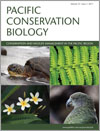
Pacific Conservation Biology
Volume 23 Number 3 2017
PCv23n3_EDWhen creativity and inventiveness go bad: problems with peer review
PC17001Ecological consequences of land clearing and policy reform in Queensland
Land clearing has increased in Queensland since a shift in policy in 2013, threatening biodiversity, impairing the functioning of terrestrial, freshwater, and marine ecosystems (particularly the Great Barrier Reef), and contributing to climate change. We review these impacts, provide an overview of the policy background, and suggest options for policy reform.
PC16041Current knowledge of the behavioural ecology of Lumholtz’s tree-kangaroo (Dendrolagus lumholtzi)
Behavioural ecology increasingly contributes to effective species conservation. This review presents our current knowledge of behavioural aspects of the Lumholtz’s tree-kangaroo (Dendrolagus lumholtzi) in relation to various conservation issues. Conclusions are drawn in regards to habitat conservation, management of fragmented landscapes, responses of the species to introduced predators, and the rehabilitation of orphaned juvenile tree-kangaroos.
PC17006Reduced efficacy of baiting programs for invasive species: some mechanisms and management implications
‘Bait-resistance’ – progressive decrease in bait efficacy over time – can develop due to changes in behaviour of the target pest species (innate and learned bait-avoidance behaviour) and increased physiological toxin-tolerance. Both are more likely to develop when animals are exposed to sublethal baits. We explore the possibility of bait resistance in the red fox (Vulpes vulpes), an introduced predator in Australia.
PC17006 Abstract | PC17006 Full Text | PC17006PDF (993 KB) Open Access Article
PC17004An invasive ant distribution database to support biosecurity risk analysis in the Pacific
Accurate information on the distributions of invasive species is important for biosecurity risk analysis. We report on distribution information for 18 key threat invasive ant species to the Pacific. Our goal is to assist Small Island Developing States with risk analysis.
PC16040Can ecological thinning deliver conservation outcomes in high-density river red gum forests? Establishing an adaptive management experiment
Evaluating ecological thinning for conservation objectives in a floodplain forest. Establishing a large-scale adaptive management manipulative experiment. Experiment structured around primary driving ecological process.
PC17008The remaining koalas (Phascolarctos cinereus) of the Pilliga forests, north-west New South Wales: refugial persistence or a population on the road to extinction?
We investigated the decline of koalas in the Pilliga forests using repeat surveys undertaken between 1990 and 2014. Koalas had declined and were found in only 21% of sites in which they were initially observed. Declines occurred evenly across the Pilliga, with persistence at a site seemingly related to a high initial density of koalas rather than to a slower rate of decline.
PC17005Preliminary observations of dingo responses to assumed aversive stimuli
A pilot assessment of the responses of a social group of dingoes on Fraser Island to hand-held stimuli presumed to be aversive was conducted. Results suggest that the efficacy of a water pistol stimulus as a repellent, possibly enhanced with a mild irritant, warrants further investigation.
PC17007Camera trap evidence of red fox (Vulpes vulpes) predation attempts on adult macropods
Camera traps detected foxes attempting to prey upon adult western grey kangaroos, despite no confirmed success of these predation events, this photographic evidence highlights the brazen behaviour of foxes, providing new insight into their hunting behaviour.



